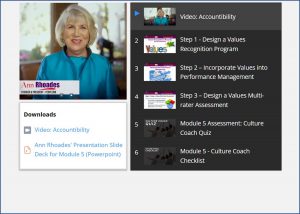By Ann Rhoades.
The Behavior of Leaders Tells the Real Values of an organizational culture.
Often, the values as they are lived bear little resemblance to stated values sanctified in a mission statement. Some leaders believe that all they need to do is proclaim a set of values and culture will magically change, but that does nothing to retool the values that control actions on the front line. Changing those inherent values takes more effort and can’t be done by any leader or executives acting alone.
A culture that works for your company— and fits with your leadership, values, products, customer desires, and employee aspirations—can only arise organically. You either encourage the behaviors you want in your culture, or they don’t happen. As leaders, we tend to identify our values and build our cultures on shared behaviors, but there is no reason why the people in our companies can’t do it on their own. The key is identifying your best employees—your A Players—and spread their values by hiring people who share those values and motivating all employees to live those values every day in their behaviors.
We call this the Values Blueprint way of changing culture.
I’ve seen it create culture change in many organizations (teams can also use this blueprint to create islands of excellence, even when top leaders are not ready to buy in (you can lead them to it by getting results).
I find that five principles form successful values-based culture change:
1. You can’t force culture—you can only create environment.
A culture is the culmination of the leadership, values, language, people, processes, rules, and other conditions, good or bad . Leaders are most instrumental in creating the environment and provide the most direct influence on it. However, they can’t create culture— only the right conditions for it to arise.
2. You are on the outside what you are on the inside—no debate.
You can’t create a great customer service organization if you treat employees badly. You can’t force people to treat customers well when they feel ill-used themselves. Organizations that are best in customer service also treat their employees best. The service you provide for your customers will never be greater than the service you provide to your employees.
3. Success is doing the right things the right way.
Well-defined values can help you, and your employees, make better decisions. In values-rich companies, the front line is where most decisions about customer service are made. So, empower front-line people with tools and knowledge to handle problems personally and immediately. The win is a happy customer who did not have to speak to a supervisor. By defining your values and the behaviors based on them, you simplify decision making: “Does that make sense in light of our values?” is all you have to ask yourself.
4. People do what they are incented to do.
Reward the right behaviors to achieve desired outcomes. This is made easier with values-based performance metrics. Also, your values will be perceived as hollow unless you base compensation and rewards on expressions of the behaviors that go with the values . Hiring and performance appraisal methods, too, must be revised to select people who display these values . And you must be courageous to fire those who don’t, including long-time employees and executives; otherwise, they’ll render your ideal culture impossible.
5. Input = Output. You get out of something what you put into it .
Values maintenance —continuous improvement —is as important as values creation. You’re never fully done with culture change; you must be vigilant that no one backslides into old ways . This requires monitoring of progress, as well as values-based leadership development and succession planning.
The culture you want can be built on shared, strategic values —and financial responsibility. Identifying shared values —and acting on them—creates a healthy culture. Those values should also be vetted in terms of responsible fiscal management. Happy-talk values that result in spending money on questionable programs are not sustainable values. A values-rich culture is likely to save millions of dollars. Values are most critical when making tough decisions—that is when they illuminate the way forward.
——————————————————————————————————————————————————————————————————————–
Published in Leadership Excellence Jan 2011 edition.
“Leadership Excellence is crisp, succinct, actionable. Quite different from the interesting, (but usually too academic or conceptual to be useful) articles in Harvard Business Review, the McKinsey Quarterly, or Strategy + Business.”-Peter G. Balbus, CEO & Managing Director of Pragmaxis)




You are on the outside what you are on the inside—no debate.
I agree with your views that “You can’t create a great customer service organization if you treat employees badly. You can’t force people to treat customers well when they feel ill-used themselves. Organizations that are best in customer service also treat their employees best. The service you provide for your customers will never be greater than the service you provide to your employees.
Your comments prompted several observations for me:
Your opening paragraph reminds me of the old saying: Values are caught, not taught. It brought to mind an experience in which leadership introduced a change initiative that quickly failed because the formal leaders routinely violated the very initiative they asked organizational members to embrace. Months later, the CEO complained about the initiative’s failure to a loyal and influential member of the organization, who replied, “We all looked around and your (formal) leaders were violating the initiative you had presented. We assumed you weren’t serious.” So leadership engagement is essential.
It is also true that front-line people may not take on an organizational culture that reflects values that are contrary to the stated values, especially if doing so puts them at cross-purposes with the organization’s “lived values” or with the behavior of formal leaders. “Is Our Industrial Culture the Problem” discusses some of the reasons for this perspective (http://www.metapower.com/pdfs/Is-Our-Industrial-Culture-The-Problem.pdf).
I agree with your suggestion that, by adopting improved values and “getting results”, teams can create culture change “when top leaders are not ready to buy in”. “Is Plant Management a Noble Endeavor?” (http://www.metapower.com/pdfs/Is-Plant-Management-a-Noble-Endeavor.pdf) contains a great example of how a plant manager in a high hazard industry did exactly this. However, this “second best” method is fraught with increased danger for those trying to drive the culture change and driving the culture change will be much more an uphill battle; “first best” requires the leaders to be on board.
Finally, I really liked your third principle, “Success is doing the right things the right way.” Clarity is both essential and empowering, another idea that is discussed in “Is Plant Management a Noble Endeavor?” (http://www.metapower.com/pdfs/Is-Plant-Management-a-Noble-Endeavor.pdf).
Carl,
Thanks for your comments and for sharing the links. I cannot think of a better reason to instill an intentional culture than to prevent industrial accidents. It’s interesting that the Chemical Safety Board is now including examining organizational culture in it’s analysis. We have done it for JetBlue and Southwest who have some of the best safety records for airlines.
It is Leaders who must drive the values through their own actions, values drive the behaviors, which become the culture, which leads to the best performance.